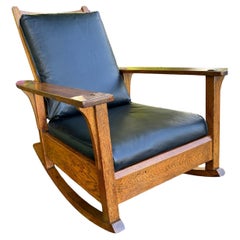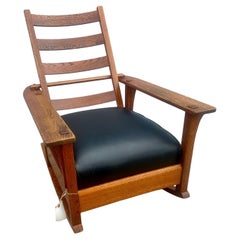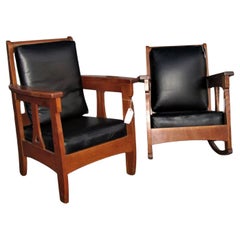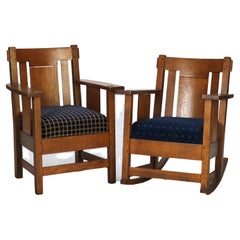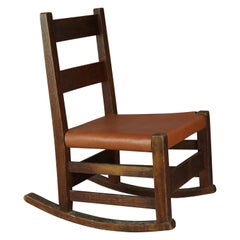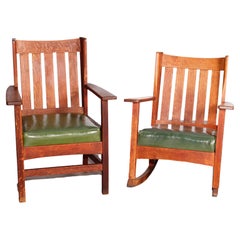Antique Stickley Rocker
Antique Early 1900s American Arts and Crafts Chairs
Oak
Antique Early 1900s American Arts and Crafts Chairs
Leather, Oak
Early 20th Century American Arts and Crafts Rocking Chairs
Leather, Cotton, Upholstery, Oak
Early 20th Century American Arts and Crafts Rocking Chairs
Leather, Upholstery, Oak
Early 20th Century American Arts and Crafts Chairs
Leather, Cotton, Upholstery, Oak
Early 20th Century American Arts and Crafts Rocking Chairs
Leather, Wool, Cotton, Oak
Early 20th Century Arts and Crafts Armchairs
Oak
Recent Sales
Early 20th Century American Arts and Crafts Rocking Chairs
Wood, Oak, Leather
Early 20th Century American Arts and Crafts Wingback Chairs
Oak
Early 20th Century American Arts and Crafts Rocking Chairs
Oak
Early 20th Century American Arts and Crafts Rocking Chairs
Oak
Early 20th Century American Arts and Crafts Rocking Chairs
Oak
Early 20th Century American Arts and Crafts Rocking Chairs
Upholstery, Oak
Early 20th Century Arts and Crafts Rocking Chairs
Oak
20th Century American Arts and Crafts Rocking Chairs
Oak
20th Century American Arts and Crafts Rocking Chairs
Upholstery, Oak
20th Century American Arts and Crafts Rocking Chairs
Oak
Early 20th Century American Arts and Crafts Rocking Chairs
Oak
20th Century North American Mission Rocking Chairs
Oak
Antique Late 19th Century American Arts and Crafts Rocking Chairs
Oak
People Also Browsed
Mid-20th Century American Arts and Crafts Chairs
Leather, Oak
Vintage 1910s American Arts and Crafts Rocking Chairs
Fabric, Oak
Early 20th Century American Arts and Crafts Chairs
Leather, Cotton, Upholstery, Oak
Early 20th Century American Arts and Crafts Rocking Chairs
Leather, Oak, Upholstery, Cotton
Early 20th Century American Arts and Crafts Chairs
Leather, Cotton, Upholstery, Oak
Antique Early 1900s American Arts and Crafts Chairs
Leather, Oak
Vintage 1910s American Arts and Crafts Settees
Steel
Antique Early 1900s American Arts and Crafts Settees
Oak
Early 20th Century American Arts and Crafts Tables
Oak
Early 20th Century American Arts and Crafts Settees
Leather, Cotton, Upholstery, Oak
Early 20th Century American Arts and Crafts Chairs
Oak, Upholstery, Cotton, Leather
Early 20th Century American Arts and Crafts Chairs
Leather, Cotton, Upholstery, Oak
Antique 1830s American Mission Mantel Clocks
Oak
Antique Stickley Rocker For Sale on 1stDibs
How Much is a Antique Stickley Rocker?
A Close Look at Arts And Crafts Furniture
Emerging in reaction to industrialization and mass production, the Arts and Crafts movement celebrated handcrafted design as a part of daily life. The history of Arts and Crafts furniture has roots in 1860s England with an emphasis on natural motifs and simple flourishes like mosaics and carvings. This work is characterized by plain construction that showcases the hand of the artisan.
The earliest American Arts and Crafts furniture dates back to the start of the 20th century. Designers working in this style in the United States initially looked to ideas put forth by The Craftsman, a magazine published by Wisconsin native Gustav Stickley, a furniture maker and founder of the Craftsman style. Stickley’s furniture was practical and largely free of ornament. His Craftsman style drew on French Art Nouveau as well as the work he encountered on his travels in England. There, the leading designers of the Arts and Crafts movement included William Morris, who revived historical techniques such as embroidery and printed fabrics in his furnishings, and Charles Voysey, whose minimal approach was in contrast to the ornamentation favored in the Victorian era.
American Arts and Crafts work would come to involve a range of influences unified by an elevation of traditional craftsmanship. The furniture was often built from sturdy woods like oak and mahogany while featuring details such as inlaid metal, tooled leather and ceramic tiles. The style in the United States was led by Stickley, whose clean-lined chairs and benches showcased the grain of the wood, and furniture maker Charles Rohlfs, who was informed by international influences like East Asian and French Art Nouveau design.
Hubs in America included several utopian communities such as Rose Valley in Pennsylvania and the Byrdcliffe Arts and Crafts Colony in New York, where craftspeople made furniture that prioritized function over any decoration. Their work would influence designers and architects including Frank Lloyd Wright, who built some of the most elegant and iconic structures in the United States and likewise embraced a thoughtful use of materials in his furniture.
Find antique Arts and Crafts chairs, tables, cabinets and other authentic period furniture on 1stDibs.
Finding the Right Rocking-chairs for You
The phrase “rocking chair” didn’t find its way into the dictionary until the mid-18th century. While most of the sitting furniture that we use in our homes originated in either England or France, the iconic rocking chair is a quintessentially American piece of furniture.
A Philadelphia cabinetmaker’s bill for a proto-rocking chair issued in 1742, which identified the seat as a “Nurse Chair with rockers,” is the earliest surviving evidence of this design’s humble beginnings. The nurse chair was a low side chair intended for nursing women, so giving it a soothing rocking motion made sense. Rocking chairs, which saw a curved slat affixed to the chairs’ feet so that they could be literally rocked, quickly gained popularity across the United States, garnering a reputation as a seat that everyone could love. They offered casual comfort without the expensive fabrics and upholstery that put armchairs out of many families’ budgets.
Rocking chairs are unique in that they don’t just offer a place to rest — they offer an opportunity to reminisce. The presence of one of these classic pieces stirs up our penchant for nostalgia and has the power to transform a space. They easily introduce a simple country feel to the city or bring the peaceful rhythm of a porch swing into a sheltered sunroom. Although craftsmen took to painting and stenciling varieties of the chairs that emerged in New England during the 19th century, the most traditional rocking chairs are generally unadorned seats constructed with time-tested materials like wood and metal. As such, a minimalist vintage rocking chair can be ushered into any corner of your home without significantly disrupting your existing decor scheme or the room’s color palette.
In the decades since the first rocker, top designers have made the piece their own. Viennese chair maker Michael Thonet produced a series of rockers in the middle of the 19th century in which the different curved steam-bent wood parts were integrated into fluid, sinuous wholes. Mid-century modernists Charles and Ray Eames added wooden rockers to their famous plastic shell armchair, while Danish designer Frank Reenskaug opted for teak and polished beech, introducing pops of color with small cushions (a precursor to the bold works that would follow in the 1970s and 1980s).
No matter your personal style, let 1stDibs pair you with your perfect seat. Deck out your porch, patio or parlor — browse the vintage, new and antique rocking chairs in our vast collection today.
- Are Stickley chairs marked?1 Answer1stDibs ExpertMarch 22, 2022Yes, Stickley chairs are usually marked. However, the markings changed over time. Early pieces have the brand burned onto the frame. Later pieces may show the name on a paper label, decal, metal plate or carved medallion. On 1stDibs, find a variety of Stickley furniture.
